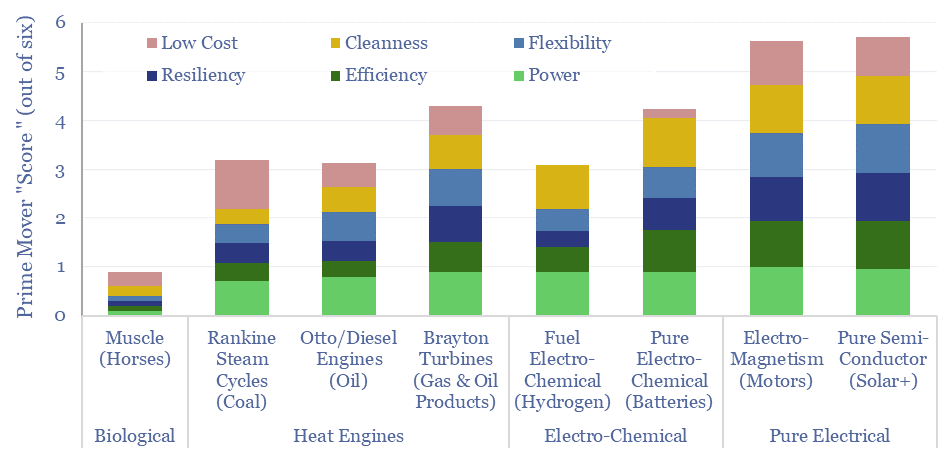A highlight of 2023 has been going back to first principles, to study the underpinnings of prime movers in the global energy system. Context matters. There is no energy source to rule them all. However, if you understand the thermodynamics of prime movers, you will inevitably conclude that the world is evolving towards solar, semi-conductors, electro-magnetic motors, lithium batteries and high-grade gas turbines.
Muscle power was the original prime mover in the pre-industrial energy system (chart below). But a typical horse outputs 0.75 kW of power, converts only c10-30% of food energy to useful work (depending on how hard you work the horse), can only cover 25-40 miles in a day, must be treated humanely and annoyingly poops everywhere. So we would score horses as a 1 out of 6 on our score of prime movers. It is remarkable that despite these limitations, the total global population of horses remains flat on 1960, with around 60 million horses in the world today, showing how hard it is to disrupt established technologies.
Heat engines changed the world, starting with coal-fired steam engines, then oil-fired engines, and later gas turbines. What is remarkable and under-appreciated when homogenizing coal, oil and gas as “fossil fuels” is that they each tend to harness totally different thermodynamic cycles. We think every serious decision-maker in energy should know the laws of thermodynamics and the basics of heat engines (primer below).
Solid fuels tend to be harnessed using the Rankine Cycle, which suffers from the limitations of steam as the working fluid, and typically achieves an efficiency of 38% (model below, again from first principles). Fuel must constantly be added, ash residue, dusts, NOx and SOx must be constantly removed. A cold start takes 6-hours and the ramp-rate is only 1-5% per minute. CO2 intensity averages 0.8-1.0 kg/kWh. So overall, we score steam cycles as a 3 out of 6 on our score of prime movers.
Gas-phase fuels can be harnessed using the Brayton Cycle, which generates work by expanding super-hot and high-pressure gases across a turbine. They can run at 1,600ºC, versus steam cycles at 300-500ºC, hence achieving simple-cycle efficiencies of 45% (data here). Then for stationary plants, an entire further steam cycle can be run on the exhaust gases exiting the turbine at 600ºC, boosting total efficiency to 60%. Dust/NOx/SOx emissions are minimal. Start times are low. Ramp rates are 5-20% per minute. Combustion is continuous. There is only one dimension of rotational movement. The turbines are compact. Insanely reliable. It is for this reason that Brayton Cycle gas turbines can be strapped to the sides of airplanes, misted with jet fuel, and safely underpin 7 trn passenger-miles of air travel per year. A strongly held view based on this theory is that Brayton cycle turbines will be a major workhorse of the 21st Century energy system, help to backstop renewables, and we score them as a 4.3 our of 6 on our score of prime movers.
Semi-conductors are the best prime movers in the world, jumping to the top of our ranking, with a score of 5.7 out of 6. Solar semiconductors harness the photovoltaic effect absorbing diffuse sunlight and then emitting a concentrated and useful direct current, which other semiconductors can then manipulate into an alternating current, then further conductors can transmit and distribute, and even further semi-conductors can manipulate into emitting light, heat or performing computational work. We have now written primers on all of these value chains below.
But for something truly remarkable, consider that this entire chain — from solar generation to Microsoft Excel model — might have ZERO moving parts. Only moving electrons. Nothing is burning. Nothing is turning. Nothing needs maintenance. Nothing is emitted. Total system efficiency is above 90%. As long as the sun is shining. If you understand the underlying theory of semiconductors, you will find it deeply uncomfortable to bet against the long-run rise of semiconductors.
Electric motors are also highly effective prime movers, awarded a score of 5.6 out of 6 on our scorecard, converting electrical energy into rotational energy, using the principles of electromagnetism. This is covered in our overview of electro-magnetism (below). Strictly, Rare Earth magnets are best, for electric vehicles and in wind turbines. And improved semi-conductors can also optimize the performance of motors that comprise around half of all global electricity consumption today.
Where electrical value chains struggle amidst the thermodynamics of prime movers is with storing electrical excitation. For this, it is necessary to turn to electrochemistry (primer below). Pure electro-chemical cells such as lithium-ion batteries have high efficiency but low energy density, which precludes their use in heavy-duty long-distance transportation, and probably always will. Plus they suffer from battery degradation. There are moving parts in a battery, in the form of ions, shuttling across the cell, and intercalating at the electrodes, undergoing unwanted side reactions along the way. Overall, we score batteries as a 4.2 out of 6 on our score of prime movers.
Finally electro-chemical fuels can have similar energy densities to hydrocarbons and low emissions. However, their round-trip efficiency is lower than Brayton cycle turbines. The key benefit of electrical systems is that they do not need to store and manage fuel, including the inevitable needs for maintenance, valves, pipes and moving parts. Resiliency is low, degradation is high, electrochemical cells perform poorly outside carefully controlled conditions such as temperature and humidity, somewhat like the Goldilocks of prime movers. This has come up in our patent screening (examples here and here). Today’s costs are also, in our view, prohibitively high. And without a willingness to pay very high green premia, we expect it may be hard to displace hydrocarbons using electro-chemical fuels.

